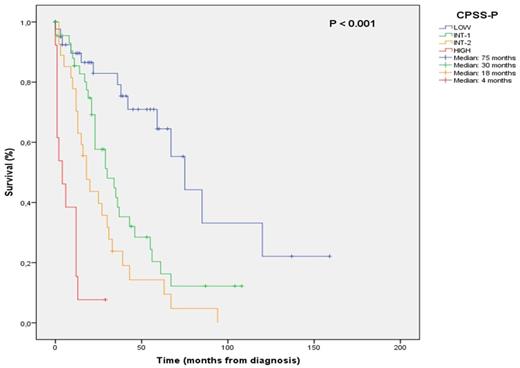Abstract
INTRODUCTION: Although specific prognostic models for Chronic Myelomonocytic Leukemia (CMML) exist, few are based on large series of patients. Since its publication in 2002, the MD Anderson prognostic score (MDAPS) has been the most powerful prognostic tool for CMML. Due to the recent emergence of the CMML-specific prognostic scoring system (CPSS) and the Mayo prognostic model, we compared the three scores to assess their usefulness in our series. These three indexes, and not those based on clinical and molecular variables (Mayo Molecular Model and GFM prognostic score), were selected as the most easy-to-apply in normal clinical practice.
AIM: 1) To assess the prognostic impact on overall survival (OS) and leukemia-free survival (LFS) of the variables composing the scores: MDAPS, CPSS and Mayo prognostic model; 2) To test the capability of the scores to detect the high-risk CMML patients; 3) To detect the index with the best predictive value for mortality and leukemia transformation, and 4) To implement a new score after selecting the best variables of the three indexes in terms of OS prognostic information.
PATIENTS AND METHODS: From January 1997 to August 2013 a retrospective analysis including 146 patients diagnosed with CMML was performed in Hospital Clínic of Barcelona (n=134) and Hospital Germans Trias i Pujol (n=12). The median age was 76 years (range 27-96 years) and 63% were males. One-hundred and twenty-nine (88%) had a CMML-1, 17 (12%) a CMML-2, 102 (70%) a CMML-MD and 44 (30%) a CMML-MP. The median follow-up for surviving patients was 24.5 months and the median OS was 20 months (range 0-159 months). The prognostic impact in terms of OS and LFS of each of the variables that compose the indexes were studied by a univariate survival analysis (Kaplan-Meier; Log-Rank). A multivariate analysis (Cox model) was performed to assess the independent impact of the variables that showed significance in the univariate analysis in order to select the ones with the best prognostic information. The global prognostic scores were analyzed by univariate and multivariate analyses. In addition, ROC curves and the concordance index (C-index) were implemented to select the score with the best predictive power for mortality or leukemia transformation.
RESULTS: All the variables that compose the MDAPS (hemoglobin level < 12 g/dl, absolute lymphocyte count > 2.5 x 109/L, presence of circulating immature myeloid cells (IMCs) and BM blasts ≥ 10%), the CPSS (CMML-MD vs. CMML-MP, CMML-1 vs. CMML-2, RBC transfusion dependency and the Spanish cytogenetic risk classification) and the Mayo prognostic model (absolute monocyte count > 10x109/L, presence of IMCs, hemoglobin < 10 g/dl and platelet count < 100 x 109/L) showed prognostic value on OS with the exception of circulating IMCs. Regarding LFS, only CPSS variables, BM blast ≥ 10% and an absolute monocyte count > 10x109/L had an impact. When the scores were applied, all showed an impact on OS and retained their significance in multivariate analysis. By using ROC curves and C-index, CPSS (ROC area: 0.80, CI 95%: 0.72-0.88; C-index: 0.73) showed a slightly better predictive value for mortality. Variables composing the three indexes were compared in a multivariate analysis and only CPSS parameters and platelets < 100 x 109/L retained their significance. Based on these findings, by adding platelet count information to CPSS, a new score was implemented (CPSS-P) showing the best risk stratification in our series (Figure 1).
CONCLUSIONS: The present study reinforces the validity of CPSS, the MDAPS and the Mayo prognostic model for the assessment of CMML patients. Moreover, by including the platelet count information to the CPSS improved the prediction capacity for OS and LFS in our series. It is of importance to remark that platelet count information could help to better stratify CMML patients, being of special value in the subset of patients with normal karyotype.
Associations Between Genetic Mutations and Clinical or Demographic Parameters
No relevant conflicts of interest to declare.
Author notes
Asterisk with author names denotes non-ASH members.


